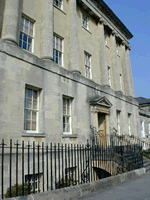Number 1, Royal Crescent in Bath
Number 1, The Royal Crescent: a house restored to its eighteenth-century state as a museum (like “The Georgian House” in Edinburgh and other period houses).
- The Entrance
- The Entrance Hall
- The Kitchen
- The Study
- The Dining Room
- The Drawing Room
- The Bedroom
- The Countess’s Levee
A Town-house in eighteenth-century Bath
Contrary to the first visitors who were content with renting lodgings, the public of the latter part of the century adopted the practice of building their own house, which encouraged financial speculation.
“NUMBER ONE” The first of the thirty houses which constitute the Royal Crescent (1767-1774) designed by John Wood the Younger had been refurbished so as to recreate a Georgian home as realistically as possible.
The entrance hall is upholstered with wallpaper imitating marble.
In the hall is displayed a sedan chair, the usual vehicle for short journeys within Bath. In an engraving by J. R. Cozens, sedan-chair porters can be seen crossing the Circus.
To the right of the entrance, you will visit the study in which a gentleman may do some reading, smoke a logn clay pipe, drink his port, play cards or write his letters.
To the left of the entrance, the dining room has been recreated at the moment of the desert, with the table-cloth removed and fruits and sweets displayed on the mahogany table.
The sitting room is situated on the first floor ; it is the most handsomely decorated room. It is hung with green damask and the Venetian blinds are made in the same material. As the room meant for entertaining guests, it is lit by a crystal chandelier and brackets with candles reflected in the mirrors. It is a room for the ladies, where they play music on the fortepiano (dated 1798), or serve tea on the oval Pembroke table placed in front of the sofa.
The bedroom to the left of the landing contains a four-poster bed, and a dressing table with veils such as may be seen in Zoffany’s painting representing Queen Charlotte in her Dressing Room.
The kitchen is to be found in the basement. It has three arches corresponding to distinct uses: from left to right, providing hot water the the various domestic needs, then in the centre cooking the dishes; the turnspit machinery is kept in motion by a dog in a wheel, under whose paws a burning coal was placed to make him move constantly (Smollett alludes to this cruel custom in The Expedition of Humphry Clinker).
The Entrance at Number 1
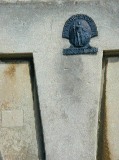
- Insurance plaque
At the door of houses were « extinguishers », metal cones in which torches would be thrust to extinguish them before entering the house (they are to be found as well in the “Georgian House” in Edinburgh).
- 1641 W. Cartwright Ordinary i. v, In putting of ’m [candles] out..by The extinguisher.
- 1685 Lond. Gaz. No. 2068/4 One Closet Candlestick, with Snuffers and Extinguisher.
- 1739-40 Mrs. Delany Life & Corr. (1861) II. 88 Put out their flambeaux with great silver extinguishers.
- 1840 Dickens Barn. Rudge xvi, Extinguishers are yet suspended before the doors of a few houses of the better sort.
- 1857 W. Collins Dead Secret i. i, She held the candlestick, so that the extinguisher lying loose in it rattled.
OXFORD ENGLISH DICTIONARY
The houses also carried insurance plaques, so that in case of fire the firemen of each company could identify the houses insured by it.
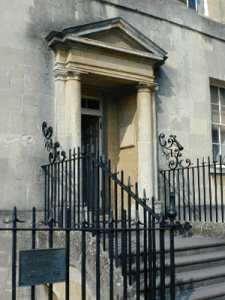
- Number 1, Royal Crescent in Bath
- [click on the picture to enlarge it]
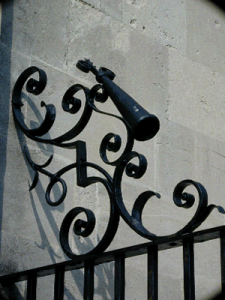
- Extinguisher
- [click on the picture to enlarge it]
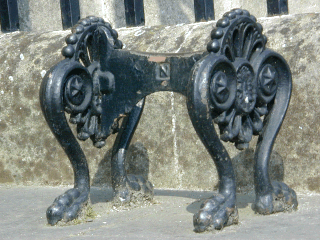
- A footscraper
- [click on the picture to enlarge it]
The Entrance Hall at Number 1
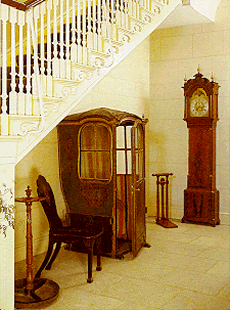
- Sedan chair
- Bath Preservation Trust
[click on the picture to enlarge it]
A sedan chair is placed under the staircase of the entrance hall (“sedan” comes from the Latin “sedere” - to be seated).
Another sedan is exhibited at the Pump Room.
Rowlandson shows a sedan tumbling on the slopes of Lansdown Crescent.
The Kitchen at Number 1
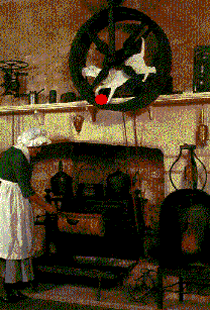
- Turnspit dogs
- [click on the picture to enlarge it]
The spits were kept in motion by dogs turning in a wheel, called “turnspit dogs”. Recipes would have included such delicacies as anchovies with Parmesan cheese or syllabub.
- 1576 FLEMING tr. Caius’ Dogs (1880) 35 A certaine dogge.. when any meate is to bee roasted they go into a wheele.. turning rounde about with the waight of their bodies… Whom the popular sort herevpon call Turnespets.
- A 1619 FLETCHER Mad Lover iii, ii, Get thee to school again, and talk of turnspits.
- 1793 [E. D. CLARKE] Tour S. Eng. Iv. 215 Dogs are universally used, in this part of the world, as turnspits.
- 1801 G. HANGER Life II. 246 These turnspits, who, in the metaphysical wheel, turn the spit of conjecture
- 1863 JESSE in Chambers Bk. Days 8 Apr. I. 490/1 His two spits…were long-bodied, crook-legged, and ugly dogs.
OXFORD ENGLISH DICTIONARY
Spits used to cook roasts were kept in motion by a mechanism linking them to a wheel in which a dog was placed with a burning coal under its paws, obliging the dog to run constantly so as to avoid being burnt.
These turnspit dogs are mentioned by Smollett and by Sheridan.
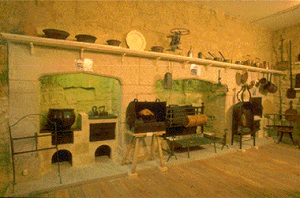
- The kitchen at Number 1, Royal Crescent in Bath
- [click on the picture to enlarge it]
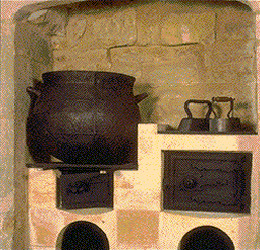
- The kitchen at Number 1, Royal Crescent in Bath
- [click on the picture to enlarge it]
The Study at Number 1
The study, which has been restored with hangings in «Zoffany blue» after one of his «conversation pieces».
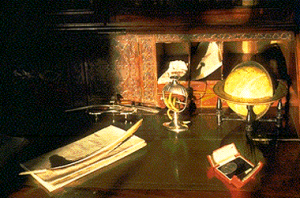
- The study at Number 1, Royal Crescent in Bath
- [click on the picture to enlarge it]
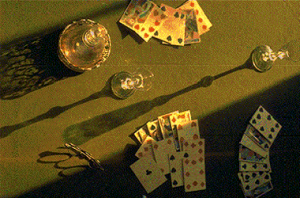
- The study at Number 1, Royal Crescent in Bath
- [click on the picture to enlarge it]
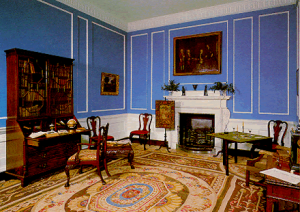
- The study at Number 1, Royal Crescent in Bath
- [click on the picture to enlarge it]
Details:
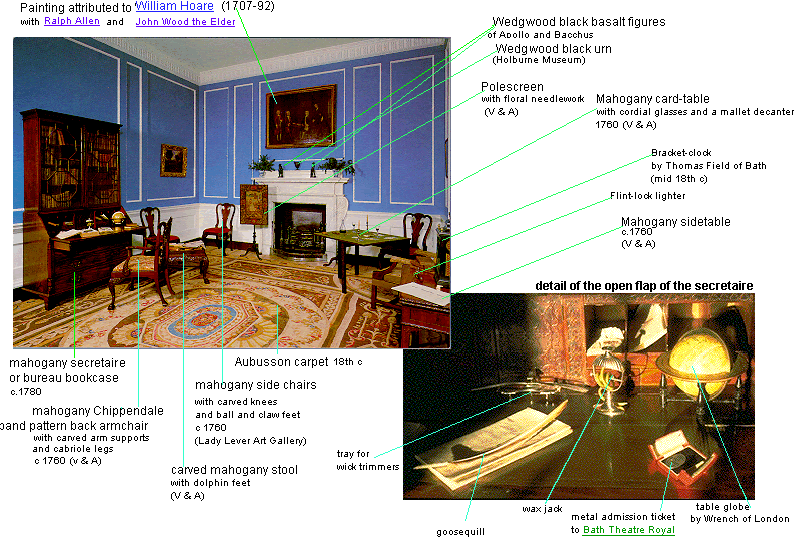
The Dining Room at Number 1
The dining room, on the gound floor, with a mahogany table and a set decorated with Aesop’s fables . Some paintings are classical landscapes (a Swanevelt), others are Georgian portraits.
“Dinner” would be taken in the afternoon. It was moved to the evening in the 19th century.
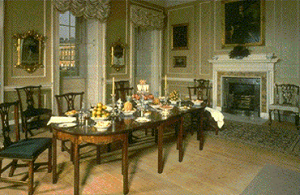
- The dining room at Number 1, Royal Crescent in Bath
- [click on the picture to enlarge it]
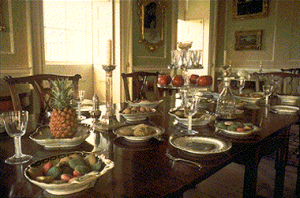
- The dining room at Number 1, Royal Crescent in Bath
- [click on the picture to enlarge it]
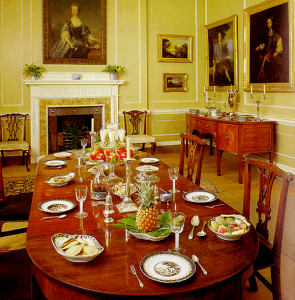
- The dining room at Number 1, Royal Crescent in Bath
- [click on the picture to enlarge it]
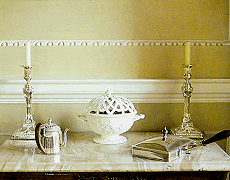
- Wedgwood creamware chestnut basket
- (Holburne Museum)
[click on the picture to enlarge it]
Details:
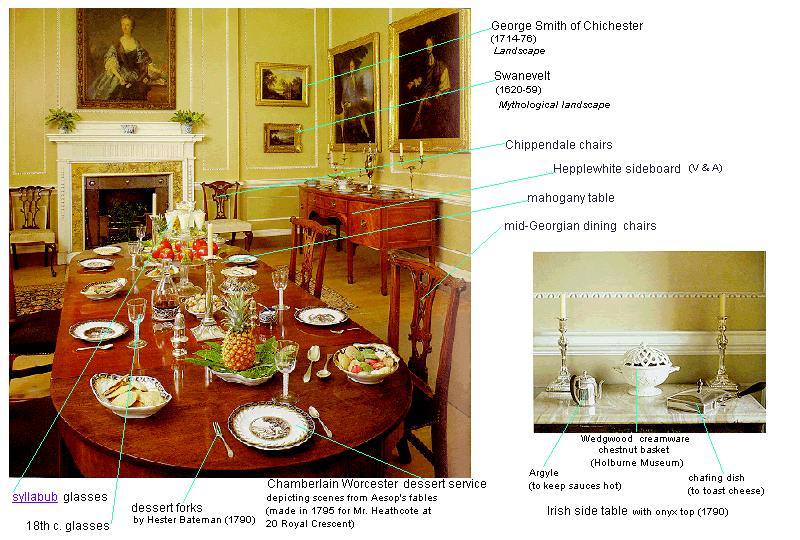
- syllabub , )
The Drawing Room at Number 1
The drawing room, on the first floor, with a 1798 fortepiano. The sofa, the armchairs and the teatable are by Hepplewhite (1765 to 1780). The furniture on either side of the fireplace is by Sheraton (1795).
A “drawing room” is so named because the ladies “withdrew” there after dinner to drink tea while the gentlemen remained in the dining room to drink port and discuss politics; they joined the ladies in the drawing room later.
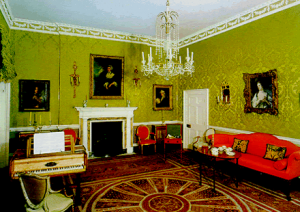
- The drawing room at Number 1, Royal Crescent in Bath
- [click on the picture to enlarge it]
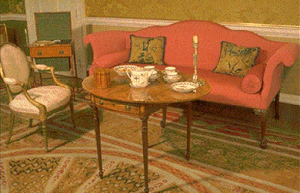
- The drawing room at Number 1, Royal Crescent in Bath
- Bath Preservation Trust
[click on the picture to enlarge it]
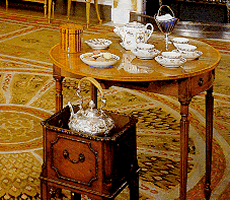
- Caughley porcelain tea service
- [click on the picture to enlarge it]
Details:
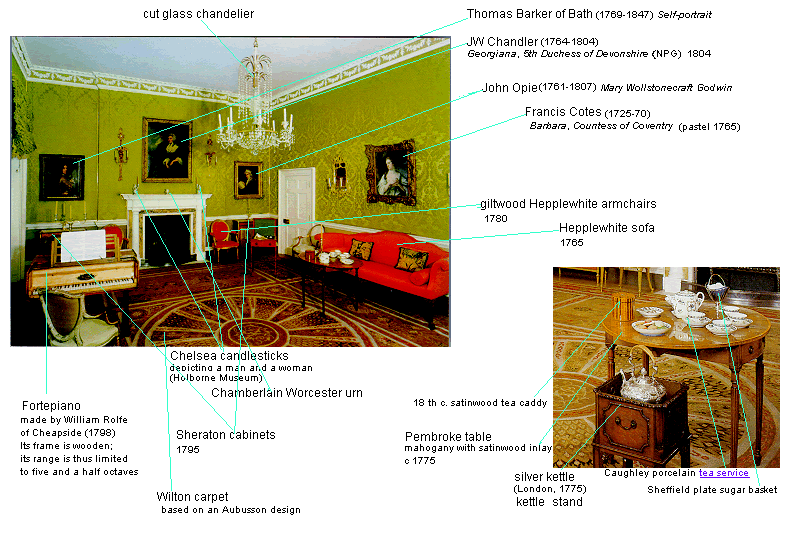
- tea service , )
The Bedroom at Number 1
The dressing table bears a mirror veiled according to the custom of the times, presumably to shield it from powder grains (one such mirror can be seen in ‘The Countess’s Levee‘ in Hogarth’s series Marriage a la Mode)
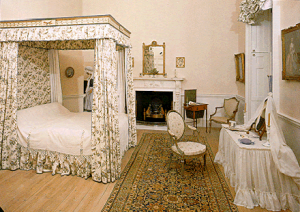
- The bedroom at Number 1, Royal Crescent in Bath
- [click on the picture to enlarge it]
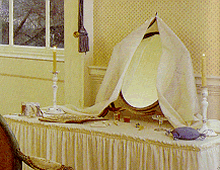
- Glass patch stand
- [click on the picture to enlarge it]
Details:
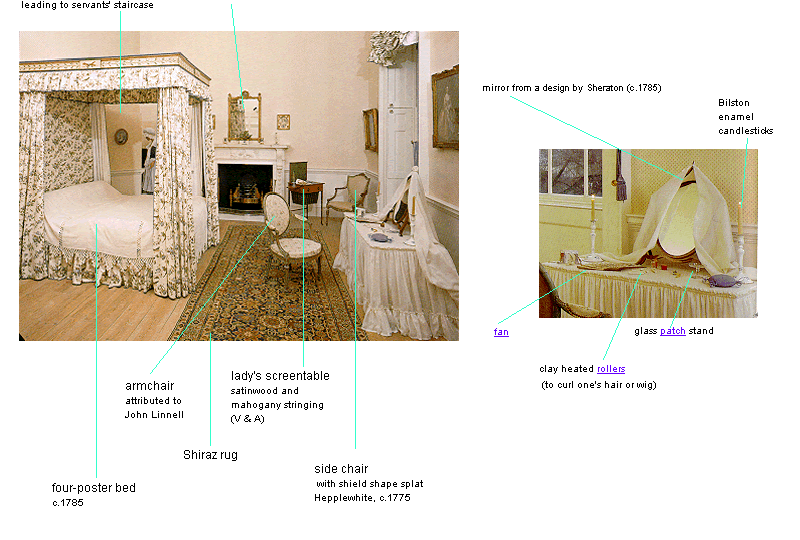
* A patch : a small piece of black silk worn on the face to show off the complexion by contrast.
Lady Mary Wortley Montagu, 1715: “Hours ... passed in deep debate, / How curls should fall, or where a patch to place.” (OED)
The Countess’s Levee
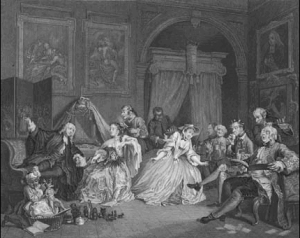
- The Countess’s Levee
- [click on the picture to enlarge it]
“The Countess’s Levee”, the fourth scene in Hogarth’s series Marriage a la Mode shows the Alderman’s daughter, now a Countess, at her toilet, allowing herself to be courted, while her husband is also having affairs.
The paintings in this series (now in the National Gallery) were also copied and distributed as a series of engravings, like many of Hogarth’s works. The scene above is from the engraved series.
The mirror is covered with veils, as in the bedroom of Number One in Bath.

